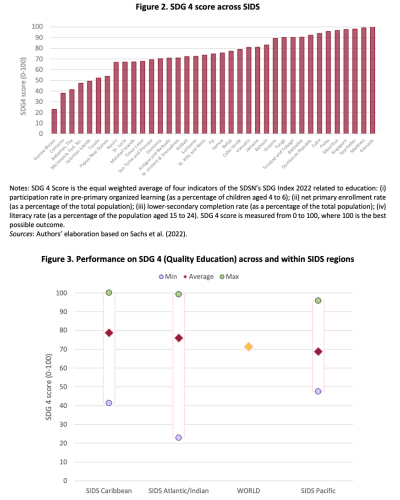How structural vulnerabilities impede progress towards achieving SDG 4 (Quality Education) in SIDS?

Isabella Massa, Leslie Bermont Díaz, Simona Marinescu, and Guillaume Lafortune
UN Sustainable Development Solutions Network in partnership with the UN Resident Coordinators offices in Small Island Developing States
Access to quality education and lifelong learning (Goal 4) is crucial to reach the ambition of the 2030 Agenda for Sustainable Development. Education is an important enabler for many Sustainable Development Goals (SDGs), ranging from no poverty and gender equality to decent work, climate action and peace, among others.
This short policy brief sheds light on the relationship between structural[1] vulnerabilities faced by countries and their ability to achieve SDG 4 (Quality Education). It builds on the pilot Multidimensional Vulnerability Index (MVI) prepared by the Sustainable Development Solutions Network (SDSN) and the UN Resident Coordinators in Small Island Developing States (SIDS), and the SDG Index and dashboards published each year by the SDSN since 2016. Overall, a higher degree of structural vulnerability (e.g. being small, remote, and as islands, being particularly exposed to natural hazards) tends to be associated with poorer performance on education at the country level. More vulnerable countries also tend to have lower capacity to invest in education due to fiscal constraints and other reasons. A high degree of structural vulnerability is found to be associated with high levels of population displacements and brain drain which negatively impact the capacity of countries to achieve SDG 4 (Quality Education) and SDG 8 (Decent Work). Structural vulnerability is also found to curb SIDS’ progress on digital transformation with consequent negative impacts on educational attainments and quality.
On 19th of September 2022, world leaders will convene at the UN Transforming Education Summit in New York to rethink education systems worldwide and revitalize governments’ efforts to achieve SDG 4 and all the SDGs as a result of enhanced human capitals. This policy brief sheds light on some of the main challenges faced by SIDS in strengthening access to and quality of education and suggests some ways forward to support countries in their efforts to plan for more comprehensive and effective education, skills, and labor policies.
[1] In this context, structural refers to the non-self-inflicted vulnerabilities that SIDS are facing stemming from their inherent characteristics of being small, remote and islands.












